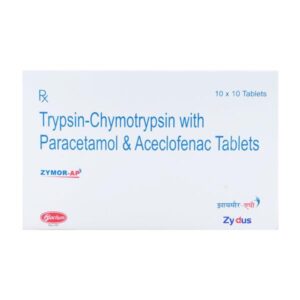ACECLOFENAC + PARACITAMOL
Aceclofenac: Aceclofenac is a nonsteroidal anti-inflammatory drug (NSAID) that is primarily used for relieving pain and inflammation associated with conditions such as rheumatoid arthritis, osteoarthritis, ankylosing spondylitis, and other musculoskeletal disorders.
The mechanism of action of Aceclofenac is multifaceted. It inhibits the synthesis of prostaglandins, which are responsible for pain, inflammation, and fever. By inhibiting cyclooxygenase (COX), Aceclofenac reduces the production of prostaglandins, resulting in the alleviation of pain and inflammation.
The usual recommended dose of Aceclofenac is 100 mg taken orally twice a day. It can be taken with or after meals, as it helps to minimize the side effects associated with the drug.
As with any medication, Aceclofenac can have side effects. Common side effects include gastrointestinal issues such as abdominal pain, heartburn, nausea, vomiting, and diarrhea. Some individuals may also experience dizziness, headache, skin rashes, and increased liver enzymes. In rare cases, more severe side effects like gastrointestinal bleeding, peptic ulcers, and allergic reactions may occur. It is important to consult a healthcare professional if any side effects persist or worsen.
Aceclofenac should not be taken by individuals who have a known allergic reaction to NSAIDs or who have a history of gastrointestinal bleeding or ulcers. It should also be used with caution in individuals with kidney or liver dysfunction, heart disease, and asthma.
Before starting Aceclofenac, it is crucial to inform your healthcare provider about any medications or supplements you are currently taking to prevent potential drug interactions or complications. They can provide personalized advice and guidance based on your specific medical condition.
Paracitamol: Drug Name: Paracetamol
Use: Paracetamol is a widely used over-the-counter medication primarily used to relieve mild to moderate pain and reduce fever. It is commonly used for headaches, muscle aches, toothaches, menstrual cramps, and to lower fever associated with common colds and flu.
Mechanism of Action: The exact mechanism of action of paracetamol is not fully understood. It is believed to work by inhibiting the production of prostaglandins in the brain that are responsible for pain and fever. Unlike nonsteroidal anti-inflammatory drugs (NSAIDs), paracetamol has little to no anti-inflammatory effect.
Dose: The recommended dose of paracetamol may vary depending on age, weight, and the severity of pain or fever. For adults, the usual dose is 325-650 mg every 4-6 hours, up to a maximum of 4,000 mg (4 grams) per day. It is important to follow the dosing instructions on the specific product and consult a healthcare professional if uncertain.
Side Effects: Overall, paracetamol is considered safe when used as directed. However, like any medication, it can cause side effects in some individuals. Common side effects include nausea, stomach pain, and rash. In rare cases, a severe allergic reaction, known as anaphylaxis, can occur, which requires immediate medical attention. Prolonged or high-dose usage of paracetamol may have adverse effects on the liver, so it is important to avoid exceeding the recommended daily dose. It is also crucial to avoid combining paracetamol with other medications containing paracetamol or drugs that can be harmful to the liver, such as alcohol. If any unusual or severe side effects occur, it is advisable to consult a healthcare professional.


